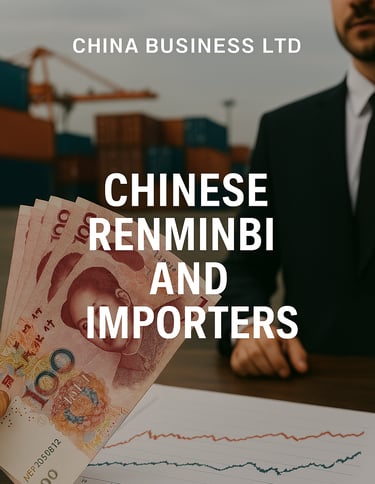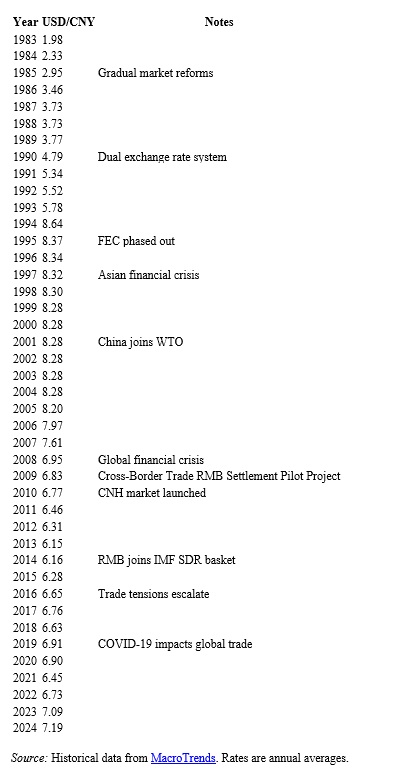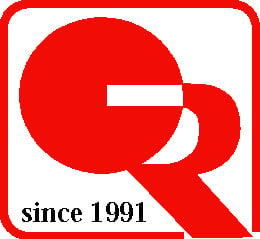The Chinese Renminbi: An Overview for Importers
Navigating the Chinese Renminbi: A Guide for Importers Understanding the RMB's dual markets—CNY (onshore) and CNH (offshore)—is crucial for managing payments, currency risks, and trade efficiency. This blog explores the history, exchange rate dynamics, hedging tools like NDFs, and the role of Hong Kong as an offshore RMB hub, equipping importers with strategies to optimize transactions in China's evolving financial landscape
CHINA/HONG KONGMARKET REPORT
5/20/20255 min read


The RMB, introduced in 1948 by the PBOC, is the official currency of mainland China, with the Yuan as its basic unit. Since the 1978 economic reforms, China has transitioned from a closed economy to the world’s second-largest by GDP, with the RMB playing an increasingly significant role in global trade. For importers, navigating the RMB’s dual markets—onshore (CNY) and offshore (CNH)—is essential for managing payments and currency risks.
CNY is traded within mainland China, regulated by the PBOC and SAFE, with a daily reference rate every morning. CNH, introduced in 2010 and primarily traded in Hong Kong, is freely convertible, offering greater flexibility for international transactions. This distinction is crucial for importers, as it affects payment methods, currency risk, and access to financial tools.
Historical Context: Foreign Exchange Certificates (FEC)
From 1980 to 1994, China used Foreign Exchange Certificates (FEC) for transactions with foreign visitors. Issued by the Bank of China, FECs were pegged to the RMB, with exchange rates ranging from US$1 = ¥2.8 FEC to ¥5.5 FEC, and used in designated shops and hotels. They facilitated foreign payments but were phased out in 1994. For modern importers, FECs are a historical footnote, but they illustrate China’s gradual economic liberalization, relevant for understanding today’s RMB dynamics.
CNY vs. CNH: Navigating Onshore and Offshore Markets
The dual nature of the RMB—CNY (onshore) and CNH (offshore)—is a key consideration:
CNY: Used for domestic transactions, CNY is subject to strict regulations and capital controls, making it ideal for direct payments to mainland suppliers but with limited convertibility.
CNH: Traded outside China, CNH is freely convertible, offering flexibility for offshore payments, hedging, and accessing RMB-denominated financial products like dim sum bonds.
While CNY and CNH exchange at a 1:1 ratio within China, their rates against other currencies (e.g., USD) can differ. For instance, USD/CNY and USD/CNH rates may vary, with CNH often being slightly weaker due to market dynamics. Importers should be mindful of these differences when converting currencies for payments or hedging, as it can impact costs.
Non-Deliverable Forwards (NDF): Hedging RMB Risk
Currency fluctuations can significantly affect import costs. Non-Deliverable Forwards (NDFs) are a financial instrument designed to hedge against RMB exchange rate risks, particularly for CNY, which is not fully convertible. An NDF is a forward contract settled in USD, where no physical delivery of RMB occurs. At maturity, the difference between the agreed forward rate and the prevailing spot rate is settled in cash, allowing importers to lock in future exchange rates and mitigate risks from RMB appreciation or depreciation.
For example, if an importer expects the RMB to appreciate, they can use an NDF to hedge, reducing uncertainty, especially during volatile periods. NDFs are particularly useful for long-term contracts or recurring payments in CNY, though they carry basis risk, as they are anchored to the PBOC’s fixing rate, while CNH deliverable forwards are more volatile.
Convertibility: Progress and Limitations
Historically, the RMB was not fully convertible due to capital controls, restricting currency flows. Since the 2008 global financial crisis, the PBOC has pursued gradual internationalization, aiming for full capital account convertibility. Key milestones include the 2009 Cross-Border Trade RMB Settlement Pilot Project, the 2010 CNH market launch in Hong Kong, the 2014 removal of Hong Kong’s daily RMB conversion cap (¥20,000) for residents, and the 2016 inclusion in the IMF’s Special Drawing Rights (SDR) basket.
Despite these reforms, CNY remains partially convertible due to ongoing capital controls, while CNH is fully convertible. For importers, this means CNY is ideal for direct payments via CIPS, but CNH offers offshore flexibility for holding RMB, trading freely, and investing in RMB-denominated assets. The PBOC’s cautious approach to full convertibility aims to maintain stability, and importers should monitor policy changes, as further liberalization could reduce transaction costs.
Advantages of Hong Kong as an Offshore RMB Hub
Hong Kong plays a pivotal role in RMB internationalization, offering unique advantages for importers:
Largest CNH Market: Hong Kong accounts for ~70% of global offshore RMB trading, with CNH deposits growing from ¥90 billion in 2010 to ¥1.5 trillion by 2014, hosting a robust infrastructure for CNH transactions.
Trade Settlement: Since 2009, Hong Kong has facilitated RMB trade settlements, allowing importers to pay suppliers in CNH, convertible to CNY at a 1:1 ratio, streamlining cross-border payments.
Financial Products: Hong Kong offers RMB-denominated products like dim sum bonds, CNH forwards, and options, enabling importers to hedge risks and optimize cash flow.
HKD Synergy: The Hong Kong dollar (HKD), pegged to the USD since 1983, provides stability, allowing importers to use HKD as a bridge currency in Hong Kong’s dual-usage environment for CNH and HKD.
Regulatory Support: The Hong Kong Monetary Authority (HKMA) and PBOC collaborate to enhance CNH liquidity, with initiatives like the Shanghai-Hong Kong Stock Connect (2014) and bilateral swap agreements, making Hong Kong the largest offshore RMB clearing center, handling ~83% of global payments.
For importers, Hong Kong’s infrastructure simplifies RMB transactions, reduces currency risk, and lowers costs. Opening a CNH account in Hong Kong or partnering with fintech platforms like Airwallex can enhance efficiency.
The Role of the People’s Bank of China (PBOC)
The PBOC, China’s central bank, regulates the RMB, shaping its value and accessibility:
Exchange Rate Management: The PBOC sets a daily CNY reference rate, and intervenes to stabilize CNY, especially during depreciation pressures.
Internationalization Efforts: The PBOC drives RMB globalization through CIPS, bilateral swap agreements (¥2.7 trillion with 25 countries by 2014), and the CNH market, reducing USD reliance for trade.
Monetary Policy: The PBOC uses tools like interest rate adjustments to influence CNY and CNH values.
Importers should stay informed about PBOC policies via financial news or PBOC announcements, as interventions can affect exchange rates and payment processes, influencing import costs.
Historical Exchange Rates: USD/CNY (1983–2024)
The RMB’s exchange rate against the USD has evolved, reflecting China’s economic reforms. Below is a table of annual average USD/CNY rates from 1983 to 2024, based on historical data:


Practical Tips for Importers
To navigate RMB complexities, importers can:
Choose the Right Currency: Use CNY for direct payments to mainland suppliers to avoid conversion fees, and CNH for offshore transactions for flexibility.
Leverage Hong Kong: Open a CNH account in Hong Kong to streamline payments and access RMB financial products, using platforms like Currencycloud or WorldFirst for efficiency.
Hedge Currency Risks: Consider NDFs for CNY exposure or CNH forwards for offshore needs, especially for long-term contracts, consulting banks with RMB expertise.
Monitor PBOC Policies: Stay updated via financial news or PBOC announcements, as interventions can impact exchange rates and payment processes.
Use CIPS for Payments: Ensure your bank is part of the Cross-Border Inter-Bank Payments System to facilitate CNY transactions directly with Chinese suppliers.
Conclusion
For importers, mastering the RMB’s dual markets, convertibility, and hedging tools like NDFs can unlock cost savings and efficiency. Hong Kong’s role as an offshore RMB hub, supported by its financial infrastructure and regulatory collaboration with the PBOC, offers significant advantages. By understanding historical trends (1983–2024) and monitoring current exchange rates, importers can navigate currency risks effectively. Partner with experienced financial institutions, leverage Hong Kong’s infrastructure, and stay informed about PBOC developments to thrive in China’s dynamic market.
Disclaimer: Exchange rate data and projections are for informational purposes only. Consult a financial advisor for personalized advice. Rates should be verified with real-time sources.
Notice any errors? Please help us rectify to get free sample!
White Label / Private Label Services
Welcome White Label / Private Label inquiries with full customization, control over Quality/Safety, and ensuring excellence in processing, packaging, and exporting of products.
Tel: +852 25172316
© 2024. All rights reserved. All information on this site is without any contractual, financial or otherwise any other liability. For binding information, please contact us and include your concerns / requirements in enquiry, quotation, contract and shipping documents.
5/Fl. Qualipak Tower, 122 Connaught Road West
Hong Kong.
China Business Ltd. T/A Orient Resources Company


Fax: +852 25178741
